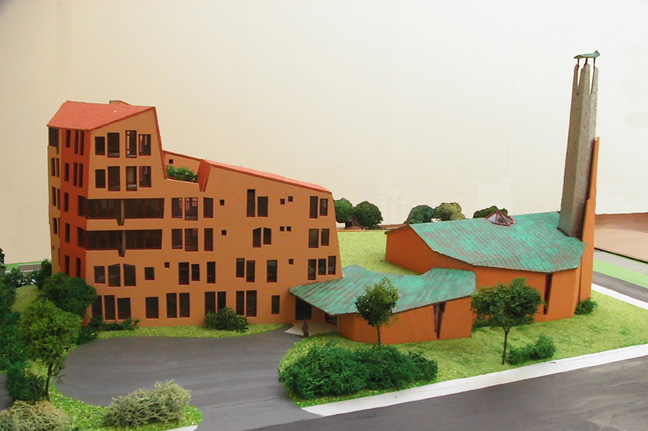|
no. 2 april - june 2007
In Madrid, José Manuel Granados, with some assistance from other Carmelites and by the JUCAR (JUventud CARmelita), teachers at the school, and others, sells paper to the recyclers. This paper is cheap (.04 euro for one kilo of newsprint and cardboard and .09 for "white paper"). Even so, they have received over 300 euros for the missions of the Baetica Province in Burkino Faso. It is one small step towards teaching the young students (and also the Carmelites) about working to keep our planet green.In the Dutch Province, the new monastery and parish church in Almelo is being designed by the Architectural firm of Alberts & van Huut because of their emphasis on "organic architecture." This means that architecture must not separate one from the environment. So the characteristics of the landscape are incorporated into the architecture of the building. The interior becomes an ecological garden, an extension of the outdoors. The result is that the architecture creates a sense of well-being for the users of the structure. The architects are very familiar with Carmelite spirituality and are incorporating this aspect into the building as well. Global warming seems to be on everyone’s minds these days. Leading scientists and evangelical Christian leaders are putting aside their differences over the origin of life and working together to fight global warming. Regardless of how our world came to be, it is in trouble now. "Whether God created the Earth in a millisecond or whether it evolved over billions of years, the issue we agree on is that it needs to be cared for today," said Rich Cizik, of the National Association of Evangelicals. The changes may not seem monumental but the impact has been phenomenal. A warming trend of 0.7 to 1.5 degrees Fahrenheit (.4 to .8 Celsius) occurred during the 20th century. Warming occurred in both the Northern and Southern Hemispheres and over the oceans according to the USA government’s Environmental Protection Agency. One study by the Intergovernmental Panel on Climate Change (IPCC) states "There is new and stronger evidence that most of the warming observed over the last 50 years is attributable to human activities." Nature itself is forcing the issue. It has caused the redrawing of the map of Greenland as large amounts of ice have melted to reveal what was thought to be a single land mass is actually one land mass with a nearby island. Rising seas, caused by global warming, overwhelmed uninhabited islands in the Pacific Ocean. But now, they have obliterated Lohachara Island in the Bay of Bengal, home to 10,000 people, the first time an inhabited island has been washed off the face of the Earth. Scientists fear it will not end there. As the seas continue to swell, they will swallow whole island nations, from the Maldives to the Marshall Islands, inundate vast areas of countries from Bangladesh to Egypt, and submerge parts of scores of coastal cities. Response of the World’s Churches The Vatican and most Episcopal conferences have said little about the various reports from the IPCC. Scientists within the IPCC claim that a reduction of between 60 and 80 percent of greenhouse gas emissions was necessary to stabilize the global climate. In January, the Pontifical Council for Justice and Peace, together with the Pontifical Academy of Sciences, hosted an international study seminar to search for solutions to the phenomenon of global warming. The conference "Climate Change and Development" was held at the end of April. Few details of the discussions were made available. The conference was intended to respond to "the voice of ecological concern raised by the UN Security Council in recent days, after a report by environment experts," the dicastery said. According to the experts’ judgment, a dicastery statement explained, "global warming may bring about not only the imposition of drastic corrective means to protect the natural environment, but also a grave threat that destabilizes the world." "On the other hand," the Vatican council added, "the development of underdeveloped countries, besides being an unavoidable necessity of social justice, is ‘the new name of peace,’ as Paul VI’s ‘Populorum Progressio’ said in a well-known expression." Four themes will be dealt with by the conference. The first was to identify the situations related to climate change and their causes. The second session will deal with climate change and sustainable development. The third session will address climate change and political responsibility. Finally, bishops from Germany, England and Australia and a representative from the World Council of Churches will address climate change and pastoral duties. According to published reports, Cardinal Renato Martino, president of the Pontifical Council for Justice and Peace, warned against idolizing the environment and losing sight of the dignity of the human person, in the wake of a conference on climate change and development. In his closing address to the conference, the Cardinal noted the problems associated with climate change, and said that "the social doctrine of the Church must deal with the many modern forms of idolatry of nature that lose sight of the person." It is generally acknowledged that the Vatican has been slow to embrace climate change. The response has been much different from the World Council of Churches (WCC). That body produced a document in 1993 entitled "Time of Peril: Test of Faith." Following the publication of that document, Cardinal Roger Etchegaray, the president of the Pontifical Council of Justice and Peace, wrote to the presidents of Episcopal conferences in industrialized countries encouraging local Churches to examine ways in which they could cooperate with any WCC-inspired initiative in their country. When The Compendium of the Social Doctrine of the Church was published in 2004, there was consensus among scientists that human-induced climate change was occurring. Only one paragraph was devoted to climate change and lacks an understanding of both the magnitude and urgency of the problem. Scientists at the time believed that we had, at the most, 20 years to take decisive action.
There is a richness within Catholic social teaching that can form the ethical basis with which to deal with climate change. It is possible to view climate change in the context of protecting the common good. That means protecting habitats, ecosystems, and the biosphere. The preferential option for the poor is particularly important because those who are least responsible for causing climate change are the ones who suffer the most. Climate change points to the ethical issues involved in intergenerational justice. The irresponsible use of fossil fuel by two or three generations can have irreversible consequence for all future generations. Concern for the wider earth community must be part of this new moral order. The Catholic Church in Australia and the American bishops have written what are generally considered to be the best Catholic statements on climate change. Pope John Paul II spoke about the need for us all to undergo an "ecological conversion." But that was seen as too little on a topic of such importance for humankind. Elsewhere in the Church there has been little official response. People, trains, animals all share the same space in the Sta. Mesa neighborhood of Manila. Students of the Filippino Commissariat spend a year living and working among the people as part of an immersion experience in their formation. United Nations Leadership on the Issue The United Nations Conference on Environment and Development (UNCED) brought together 117 heads of state and government in Rio de Janeiro, Brazil, on June 3–14, 1992. Popularly known as "The Earth Summit," the historic meeting produced an 800 page document called "Agenda 21." It laid out global measures to protect the planet’s environment while guaranteeing sustainable economic growth. The conference also spawned a new functional commission of ECOSOC, the Commission on Sustainable Development, which has a mandate to monitor international treaties on the environment, provide policy direction, and coordinate action within the United Nations system to achieve the goals of Agenda 21. The Earth Summit also produced two important conventions on the environment which were widely endorsed: the Global Warming Convention, which set guidelines for regulating emissions of gases believed to cause global warming (signed by 153 nations); and the Biodiversity Convention, which committed signatory nations to protection of endangered species and cooperation on genetic and biological technology (signed by 150 countries). Two important documents outlining the principles behind the concept of sustainable development also were widely adopted: the Statement on Forest Principles, recommending preservation of world forests and monitoring of development impact on timberlands; and the Declaration on Environment and Development, a statement of principles that emphasized the coordination of economic and environmental concerns. As is the case in most United Nations actions, many controversial propositions had to be deleted or scaled down in the final documents to achieve the final consensus. Negotiators removed or excluded specific targets on pollution controls, resource protection, and financial aid to developing countries that restrain their economic development in order to protect their natural resources. The "Green Fund" which developing countries had sought to support their efforts to implement environmentally sustainable development was dropped. The G-7 group of industrialized countries succeeded in specifying that such development funds would be channeled through the World Bank’s Global Environment Facility (GEF). Also deemphasized in the final documents were references to population control. Passages referring to contraception were completely deleted at the insistence of an odd coalition that included the Vatican, Roman Catholic countries, and Moslem countries. At the Earth Summit+5 (years) meeting held in June 1997 in New York
City, the participants worked to revitalize and energize commitments to
sustainable development, to recognize failures and identify their causes,
to recognize achievements, to define priorities for the post-97 period,
and to raise the profile of issues addressed insufficiently by Rio. The
program of action for the sustainable development of Small Island
Developing States (SIDS), developing integrated management and planning of
land resources, and developing strategic approaches to freshwater
management received new focus. There were many Agenda 21 success stories
that were highlighted during the event but much remains to be done. This article is a compilation of information from articles published in The Tablet, January 27, 2007, March 10, 2007 and the National Catholic Reporter of January 26, 2007. For more information:
|
||
|
RETURN TO THE INDEX FOR 2007 | RETURN TO THE INDEX FOR THIS ISSUE INDEX OF CARMELITE
WEBSITES |


